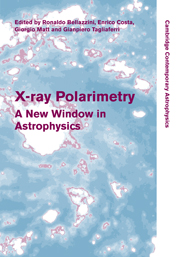Book contents
- Frontmatter
- Contents
- List of contributors
- Preface
- 1 X-ray polarimetry: historical remarks and other considerations
- Part I Polarimetry techniques
- Part II Polarized emission in X-ray sources
- 14 Probing strong gravity effects with X-ray polarimetry
- 15 X-ray polarization from black holes in the thermal state
- 16 Strong-gravity effects acting on polarization from orbiting spots
- 17 Polarization of thermal emission from accreting black holes
- 18 X-ray polarimetry and radio-quiet AGN
- 19 The soft X-ray polarization in obscured AGN
- 20 The polarization of complex X-ray sources
- 21 Polarization of Compton X-rays from jets in AGN
- 22 Polarization of X-ray lines from galaxy clusters and elliptical galaxies
- 23 Polarization characteristics of rotation-powered pulsars
- 24 Polarized X-rays from magnetized neutron stars
- 25 Polarization properties of X-ray millisecond pulsars
- 26 X-ray polarization signatures of neutron stars
- 27 Polarization from the oscillating magnetized accretion torus
- 28 X-ray polarization from accreting white dwarfs and associated systems
- 29 Polarization of pulsar wind nebulae
- 30 X-ray polarization of gamma-ray bursts
- 31 Central engine afterglow from GRBs and the polarization signature
- 32 GRB afterglow polarimetry past, present and future
- 33 Gamma-ray polarimetry with SPI
- 34 INTEGRAL/IBIS observations of the Crab nebula and GRB 041219A polarization
- 35 Fermi results on the origin of high-energy emission in pulsars
- 36 Diagnostics of the evolution of spiral galaxies in a cluster environment
- Part III Future missions
- Author index
- Subject index
23 - Polarization characteristics of rotation-powered pulsars
from Part II - Polarized emission in X-ray sources
Published online by Cambridge University Press: 06 July 2010
- Frontmatter
- Contents
- List of contributors
- Preface
- 1 X-ray polarimetry: historical remarks and other considerations
- Part I Polarimetry techniques
- Part II Polarized emission in X-ray sources
- 14 Probing strong gravity effects with X-ray polarimetry
- 15 X-ray polarization from black holes in the thermal state
- 16 Strong-gravity effects acting on polarization from orbiting spots
- 17 Polarization of thermal emission from accreting black holes
- 18 X-ray polarimetry and radio-quiet AGN
- 19 The soft X-ray polarization in obscured AGN
- 20 The polarization of complex X-ray sources
- 21 Polarization of Compton X-rays from jets in AGN
- 22 Polarization of X-ray lines from galaxy clusters and elliptical galaxies
- 23 Polarization characteristics of rotation-powered pulsars
- 24 Polarized X-rays from magnetized neutron stars
- 25 Polarization properties of X-ray millisecond pulsars
- 26 X-ray polarization signatures of neutron stars
- 27 Polarization from the oscillating magnetized accretion torus
- 28 X-ray polarization from accreting white dwarfs and associated systems
- 29 Polarization of pulsar wind nebulae
- 30 X-ray polarization of gamma-ray bursts
- 31 Central engine afterglow from GRBs and the polarization signature
- 32 GRB afterglow polarimetry past, present and future
- 33 Gamma-ray polarimetry with SPI
- 34 INTEGRAL/IBIS observations of the Crab nebula and GRB 041219A polarization
- 35 Fermi results on the origin of high-energy emission in pulsars
- 36 Diagnostics of the evolution of spiral galaxies in a cluster environment
- Part III Future missions
- Author index
- Subject index
Summary
Polarization measurements of rotation-powered pulsars have been a very powerful diagnostic in the radio band and promise to be at least as useful a diagnostic in the X-ray band. Since the relativistic particles that radiate pulsar high-energy emission tightly beam the radiation along the pulsar magnetic field, phase-resolved polarimetry has the potential to map the emission patterns. Fermi observations of young pulsars at gamma-ray energies have disfavored polar-cap models where emission takes place near the neutron star surface, and strongly favor outer-magnetosphere models where emission takes place close to the light cylinder or beyond. Since the different outer-magnetosphere models predict similar gamma-ray light curves, it is difficult to discriminate between them at gamma-ray energies. But X-ray polarization has the potential to provide this discrimination, since the models predict distinct polarization signatures and optical detections will only be possible for a small number of pulsars.
Introduction
Rotating systems are particularly interesting to study with polarization because the rotation provides changing views of the emitting regions. Rotation-powered pulsars have the additional advantage that the emission is radiated by highly relativistic particles moving along magnetic field lines and therefore the emission angle measures the field direction to within an angle of 1/γ, where γ is the particle Lorentz factor. The magnetic field structure is also able to be derived independently, using either retarded-vacuum, force-free (e.g.) or pair-starved solutions.
- Type
- Chapter
- Information
- X-ray PolarimetryA New Window in Astrophysics, pp. 150 - 156Publisher: Cambridge University PressPrint publication year: 2010
- 1
- Cited by

